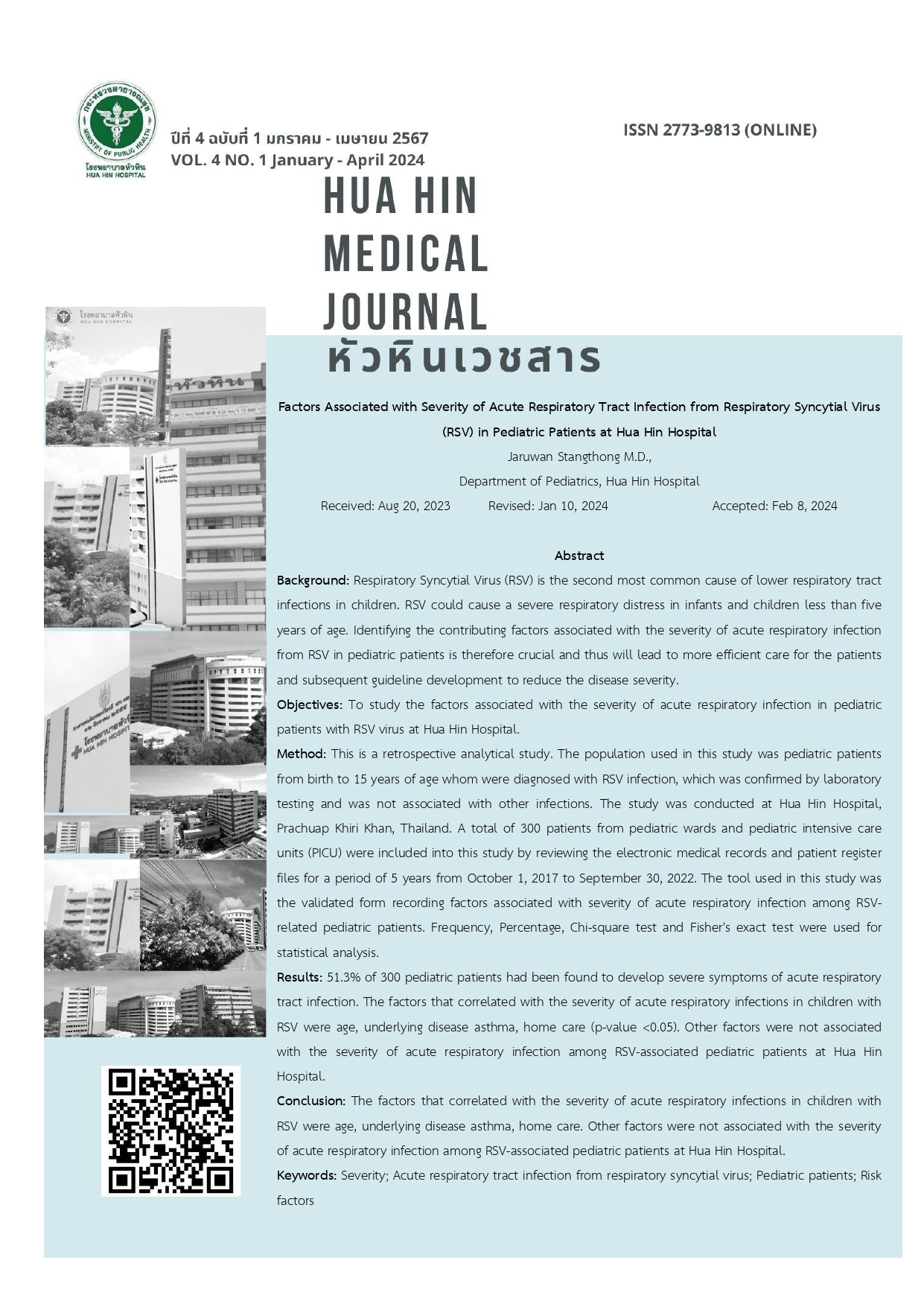Factors Associated with Severity of Acute Respiratory Tract Infection from Respiratory Syncytial Virus (RSV) in Pediatric Patients at Hua Hin Hospital
Keywords:
Severity, Acute respiratory tract infection from respiratory syncytial virus, Pediatric patients, Risk factorsAbstract
Background: Respiratory Syncytial Virus (RSV) is the second most common cause of lower respiratory tract infections in children. RSV could cause a severe respiratory distress in infants and children less than five years of age. Identifying the contributing factors associated with the severity of acute respiratory infection from RSV in pediatric patients is therefore crucial and thus will lead to more efficient care for the patients and subsequent guideline development to reduce the disease severity.Objectives: To study the factors associated with the severity of acute respiratory infection in pediatric patients with RSV virus at Hua Hin Hospital.Method: This is a retrospective analytical study. The population used in this study was pediatric patients from birth to 15 years of age whom were diagnosed with RSV infection, which was confirmed by laboratory testing and was not associated with other infections. The study was conducted at Hua Hin Hospital, Prachuap Khiri Khan, Thailand. A total of 300 patients from pediatric wards and pediatric intensive care units (PICU) were included into this study by reviewing the electronic medical records and patient register files for a period of 5 years from October 1, 2017 to September 30, 2022. The tool used in this study was the validated form recording factors associated with severity of acute respiratory infection among RSV-related pediatric patients. Frequency, Percentage, Chi-square test and Fisher's exact test were used for statistical analysis.Results: 51.3% of 300 pediatric patients had been found to develop severe symptoms of acute respiratory tract infection. The factors that correlated with the severity of acute respiratory infections in children with RSV were age, underlying disease asthma, home care (p-value <0.05). Other factors were not associated with the severity of acute respiratory infection among RSV-associated pediatric patients at Hua Hin Hospital.
Conclusion: The factors that correlated with the severity of acute respiratory infections in children with RSV were age, underlying disease asthma, home care. Other factors were not associated with the severity of acute respiratory infection among RSV-associated pediatric patients at Hua Hin Hospital.
References
อลิษา ขุนแก้ว, เสน่ห์ ขุนแก้ว, บุษกร ยอดทราย, ปณัชญา เชื้อวงษ์. บทบาทพยาบาลกับการดูแลเด็กที่ติดเชื้อไวรัส RSV. NJPH. 2020;30(2):36-45.
Cai W, Buda S, Schuler E, Hirve S, Zhang W, Haas W. Risk factors for hospitalized respiratory syncytial virus disease and its severe outcomes. Influenza Other Respir Viruses. 2020;14(6):658-670.
Gong L, Wu C, Lu M, Huang C, Chen Y, Li Z, et al. Analysis of Incidence and Clinical Characteristics of RSV Infection in Hospitalized Children: A Retrospective Study. Risk Manag Healthc Policy. 2021;14:1525-1531.
น้ำทิพย์ เหนี่ยงจิตต์. อัตรายจากการติดเชื้อไวรัส RSV ในเด็กเล็ก. RTAFMG. 2018;64(3):96-100.
Aikphaibul P, Theerawit T, Sophonphan J, Wacharachaisurapol N, Jitrungruengnij N, Puthanakit T. Risk factors of severe hospitalized respiratory syncytial virus infection in tertiary care center in Thailand. Influenza Other Respir Viruses. 2020;15:1-8.
กรมควบคุมโรค. แนะผู้ปกครองดูแลบุตรหลานหวั่นป่วยด้วยโรคติดเชื้ออาร์เอสวี (RSV) [อินเทอร์เน็ต]. กรุงเทพฯ: กรมควบคุมโรค กระทรวงสาธารณสุข; 2565 [17 กันยายน 2565].เข้าถึงได้จาก: https://goodhealth.moph.go.th/?url=pr/detail/2/02/178815/.
Walsh EE, Hall CB. Respiratory Syncytial Virus (RSV): Mandell, Douglas, and Bennett's Principles and Practice of Infectious Diseases. 2015:1948(e1)-1960(e3). doi:10.1016/B978-1-4557-4801-3.00160-0. Epub 2014 Oct 31.
พรอำภา บรรจงมณี, อมรรัตน์ โรจน์จรัสไพศาล, อัจฉรา ตั้งสถาพรพงษ์. ระบาดวิทยา อาการและอาการแสดง ปัจจัยเสี่ยงของการติดเชื้อทางเดินหายใจจากเชื้อ respiratory syncytial virus ในเด็กที่เข้ารับการรักษา ณ โรงพยาบาลธรรมศาสตร์เฉลิมพระเกียรติ. TMJ.2016;16(3):370-378.
Havdal L, Bøås H, Bekkevold T, Kran A-M, Rojahn A, Størdal K, et al. Risk factors associated with severe disease in respiratory syncytial virus infected children under 5 years of age. Front Pediatr. 2022;10.doi: 10.3389/fped.2022.1004739. PMCID:9468371.
Nuntiyagul T. Clinical Characteristics and Factors Associated with Severity of Lower Respiratory Tract Infection from Respiratory Syncytial Virus (RSV) in Pediatric Patients at Chaoprayayommarat Hospital. Dis Control J. 2023;49(2):293-303. doi: 10.14456/dcj.2023.25
Shi T, Balsells Hernández E, Wastnedge E, Singleton R, Rasmussen Z, Zar H, et al. Risk factors for respiratory syncytial virus associated with acute lower respiratory infection in children under five years: Systematic review and meta-Analysis. J Glob Health. 2015;5(2):1-13. J Glob Health
Nguyen SN, Nguyen TNT, Vu LT, Nguyen TD. Clinical Epidemiological Characteristics and Risk Factors for Severe Bronchiolitis Caused by Respiratory Syncytial Virus in Vietnamese Children. Int J Pediatr. 2021;2021:

Downloads
Published
How to Cite
Issue
Section
License
Copyright (c) 2024 Hua-Hin Hospital

This work is licensed under a Creative Commons Attribution-NonCommercial-NoDerivatives 4.0 International License.
บทความที่ได้รับการตีพิมพ์ในวารสารหัวหินเวชสาร เป็นลิขสิทธิ์ของโรงพยาบาลหัวหิน
บทความที่ลงพิมพ์ใน วารสารหัวหินเวชสาร ถือว่าเป็นความเห็นส่วนตัวของผู้เขียนคณะบรรณาธิการไม่จำเป็นต้องเห็นด้วย ผู้เขียนต้องรับผิดชอบต่อบทความของตนเอง






